
Features
Applications
Beef
$100 million invested in bio-energy expansion and ethanol plant
January 29, 2009 by Tony Kryzanowski
Some of Alberta’s sharpest minds have banded together to construct one
of the most energy efficient ethanol production plants in the world,
and given beef’s prominence in this Western Canadian province, it
should come as no surprise that the energy input solution starts with a
cow.
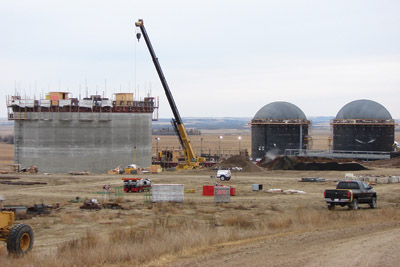
|
Some of Alberta’s sharpest minds have banded together to construct one of the most energy efficient ethanol production plants in the world, and given beef’s prominence in this Western Canadian province, it should come as no surprise that the energy input solution starts with a cow.
Burning biogas generated from anaerobic digestion of feedlot manure exclusively to provide energy and steam to the ethanol plant is what makes this project so efficient. However, it took a breakthrough in manure separation technology to give the developers’ ethanol plant concept a serious chance for success.
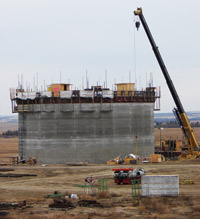 |
|
| To accommodate the energy needs of a proposed ethanol plant, Highmark Renewable’s anaerobic digester is being expanded so that it can process 80 percent of the manure generated at an adjacent feedlot, which raises more than 70,000 head of cattle annually. Advertisement
|
Here’s how the concept works. Cattle manure generated from one of Canada’s largest feedlots will be processed through an anaerobic digester, which will produce the biogas that will be used as fuel in a power plant. Electricity and steam produced by the power plant will then be used in ethanol production, while grain byproducts from ethanol production will be fed back to the cattle. The process works in a continuous loop, and the dividend to the cattle industry is that two new products are manufactured in the process – power and ethanol.
For this entire production loop to work efficiently, it was necessary to first overcome the problem of sand buildup in the anaerobic digester. Sand is part of the raw manure mix because the digester feedstock is gathered from outdoor cattle feedlot pens. New separation technology has been developed so that there is no sand buildup in the digester, making it possible for other cattle feedlots to buy into this concept. Processing manure in this way also overcomes the problem of how to manage the millions of tons of waste products generated by cattle feedlots every year.
The site of the $100 million bio-energy expansion and ethanol plant project is where a company called Highmark Renewables has already constructed its Integrated Manure Utilization System (IMUS) pilot plant. The IMUS plant is situated next to a large feedlot located near Vegreville, Alta., about an hour and a half east of Edmonton. Launched in 2004, research at the IMUS facility has advanced the technology to use feedlot-based cattle manure as the feedstock to produce biogas.
In addition to managing their feedlot for more than 20 years, Highmark Renewables owners Bern and Mike Kotelko have long believed in the extra value inherent in manure.
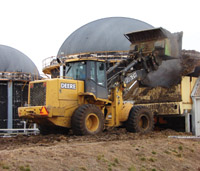 |
|
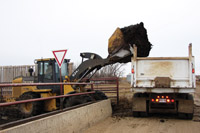 |
|
| At present, the IMUS plant uses 20 percent of the feedlot’s manure and produces enough biogas to generate 1 megawatt of power, selling most of it to the provincial power grid. |
“We knew we had to add more value and we knew manure wasn’t waste,” says Bern. A professional agrologist, he and his brother, Mike, helped to develop the feedlot adjacent to the IMUS project from a small mixed farming operation to an agribusiness with about $60 million in annual revenue. This consists of a branded beef operation called Spring Creek Ranch, where cattle are raised without hormones or antibiotics, and a large commercial feedlot operating as Highland Feeders. Mike has taken a strong leadership role in the Highmark Renewables branch operation, holds a diploma in agriculture engineering, and is co-inventor of the IMUS technology. He continues to oversee its development and marketing.
The unique aspect to IMUS is its ability to process high solids, high fibre, organic wastes from outdoor feedlots. All other digesters in Europe and in Canada are tied into hog and dairy operations where livestock are housed on slatted or concrete floors.
“There aren’t any other feedlots in the world that will harvest manure for biogas production out of open pens and where the cattle aren’t on concrete,” says Bern. The problem is that manure collected from open, earthen pens has up to 40 percent sand, silt and mud. While the lighter material floats to the top and can be sucked out of the anaerobic digester, the sand settles to the bottom.
“There is not very much sand in the manure and it takes a whole year to fill up the digester,” Bern says. “But when it’s full, it’s no fun. There’s only one way to get it out and that’s with a shovel.”
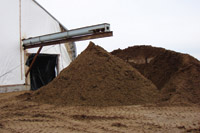 |
|
| The unique aspect to IMUS is its ability to process high-solids, high-fibre, organic wastes from outdoor feedlots. New separation technology has been developed so that there is no sand buildup in the digester. |
|
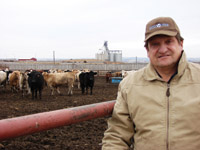 |
|
| Bern Kotelko, a professional agrologist, and his brother, Mike, helped to develop the feedlot adjacent to the IMUS project from a small mixed farming operation to an agribusiness with about $60 million in annual revenue. This consists of a branded beef operation called Spring Creek Ranch and a large commercial feedlot operating as Highland Feeders. |
|
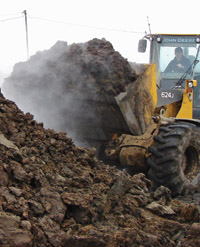 |
|
| Cattle manure generated from one of Canada’s largest feedlots is being used to feed Highmark Renewables’ Integrated Manure Utilization System (IMUS) anaerobic digester. |
So there was a need for new separation technology to overcome this problem. Highmark Renewables has developed several proprietary technologies, which greatly improve the efficiency of its anaerobic digestion systems. Now proven on a pilot and commercial scale, the company’s technology is moving into the integrated bio-refinery realm, which involves biofuel and bio-fertilizer production.
In doing so, the Kotelko’s partnered with Evan and Shane Chrapko, who are probably best known for launching, building and selling a technology company called The DocSpace Company for $568 million over a span of 30 months. Shane holds a bachelor of science degree in agriculture from the University of Alberta, and Evan holds a bachelor of commerce degree, also from the University of Alberta. He is also a lifetime member of American MENSA.
Full utilization of the energy potential from biogas is essential to build a commercially viable anaerobic digestion system and this is what really got the partners thinking about the integration of ethanol production into their first bio-refinery operation.
“Ethanol production uses all the heat year round,” says Kotelko. “Now you have full utilization from your biogas production because you are using both the electricity and the heat, producing ethanol with zero added energy. The only energy needed is to haul the wheat here and to take the ethanol to market.”
Because this bio-refinery integration is designed from the ground up, many new innovations were developed and built into the system resulting in far superior energy and water efficiencies along with greenhouse gas (GHG) reductions reaching just over 143,000 tons annually.
Once in production, the ethanol plant will consume about 120,000 tons of wheat to produce about 10.5 million gallons of ethanol annually. The wet distillers grains (WDGs) produced as a byproduct from the ethanol production process will be used as cattle feed, eliminating 30 percent of the feedlot’s barley requirements. Given the IMUS plant’s close proximity to grain sources, using the waste heat to generate steam needed in ethanol production, as well as expanding anaerobic digestion capacity, seemed like the next most logical step.
Waste heat is generated by the V20 engine that burns the biogas and drives the power generator. It is estimated that 40 percent of the energy emanating from the engine is in the form of heat, making an ideal fit for the ethanol process.
More strategic partners have been added to the ethanol plant development. It now is a four-member consortium. The members are Highmark Renewables Research LP, Growing Power Hairy Hill LP, FWS Group of Companies, and Providence Grain Corp.
The IMUS anaerobic digester, with its patented digestion method, is a critical element to this value-adding loop. To accommodate the needs of the ethanol plant, the digester is being expanded so that it can process 80 percent of the manure generated at the feedlot, which raises more than 70,000 head of cattle annually. This amounts to about 550 tons of raw manure per day or 198,000 tons annually. At present, the IMUS plant uses 20 percent of the feedlot’s manure and produces enough biogas to generate 1 megawatt of power, selling most of it to the provincial power grid. Once expansion is complete at the beginning of 2010, the digester will produce enough biogas for a 5-megawatt power plant. Since the bio-refinery needs more steam than power, 2.4 megawatts of electrical production is all that is needed. The remaining biogas will fuel a large steam boiler. About 400 kilowatts of electricity will continue to flow to the provincial grid, while the remainder will be used within the bio-refinery. The new digester will also generate about 33,000 tons of premium bio-fertilizer as a byproduct of the digestion process. This bio-fertilizer is odorless, weed-, seed- and pathogen-free, and works well as a soil revitalizer.
This integrated approach to ethanol production addresses many of the public’s concerns about using a food product to manufacture an energy additive, says Kotelko, who is also president of GPHH. A food product is not being used to produce a fuel additive, as the WDGs generated as a byproduct of the ethanol manufacturing process will be fed to the feedlot cattle, which eventually head to a meat packing plant and become a variety of food products.
Because it uses energy and steam derived from the burning of biogas produced from cattle manure, this method of ethanol production delivers four units of ethanol energy for every one fossil energy unit consumed, versus the 1.25 to 1 ratio in many existing ethanol plants. The reduction in greenhouse gas emissions also makes it possible of GPHH to market carbon credits.
From an environmental standpoint, it means that a lot less untreated manure will be spread on adjacent farmland.
“That is why this system works so well,” says Kotelko, “because it mitigates all those issues that intensive livestock operations have with local residents.”
With the advances it has made, particularly in material separation, Highmark Renewables is actively marketing IMUS around the world. Inquiries are coming from as far away as South Africa.